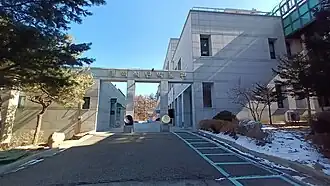Taebaek Coal Museum
태백석탄박물관 | |
 Front entrance featuring stone sculptures of yeontan. | |
| Established | May 27, 1997 |
|---|---|
| Location | 195 Cheonjedan-gil, Taebaek-si, Gangwon Province, South Korea |
| Coordinates | 37°07′01″N 128°57′00″E / 37.117°N 128.950°E |
| Website | http://www.coalmuseum.or.kr/ |
Taebaek Coal Museum (Korean: 태백석탄박물관) is a museum on South Korean coal industry.[1] It is located in Taebaek, Gangwon Province, South Korea.
History
Coal powered much of South Korea's industrial development during the 1960s and 1970s,[2] following the discovery of the country's first coal deposits in Taebaek city in 1930. As demand for coal declined in the 1980s, the city's economy dwindled as mines shut down and its population shrank.[3]
The creation of the museum was part of an effort to revitalize the region. Basic plans for the museum were formed in 1989, and the blueprints were finalized in October 1933. The construction began in June 1994. The museum officially opened in 27 May 1997 as a Type 1 specialized museum (Registration No. 101). The museum originally had no entrance fee, but switched to paid entry on 2017 January 10.[1][2] It has been absorbed by and operated by Taebaeksan Provincial Park Office (태백산도립공원사업) since 1998.[2]
The museum has hosted multiple art exhibitions relating to coal. From July 2024 to August, an exhibition titled "The Physical Properties of Coal Dust and the Emotions of Highland Scenery" (석탄가루의 물성과 고원풍경의 감성), showcased 최법진's paintings which was drawn using only coal dust.[4] In 2022, the museum held a coal mine photography contest and a gallery.[5][6][7]
In 2021, the Ministry of Culture, Sports and Tourism handed the museum a 10,000,000 South Korean won grant to create audio guides, develop mission-based exhibits, and integrate technologies like augmented reality.[8]
February 2025 saw a 38.5% increase in visitor count year-over-year, corresponding with the city seeing a 25% increase in tourists.[9]
In May 2025, the museum announced plans to install a "slow mailbox", where letters are delivered one year after being sent, as part of a collaboration with local post offices and tourist destinations.[10]
Exhibits

The museum occupies a site area of 23,811㎡ (~7,203 pyeong), with an exhibition area of 11,576㎡ (~3,502 pyeong).[2] The museum has 3 aboveground floors, one basement floor, and a large outside section. The museum's eight exhibits[2] contain historical documents, minerals, fossils, and mining equipment.[1][11]
Further readings
- 태백석탄박물관 : 석탄과 자연 그리고 인간 [Taebaek Coal Museum: Coal, Nature, and Human]. Taebaek Coal Museum. 2003.
References
- ^ a b c 이, 영식. "태백 석탄박물관". 지역N문화 (in Korean). The Federation of Korean Cultural Centers. Retrieved 2025-04-27.
- ^ a b c d e 김, 대진, "태백석탄박물관 (太白石炭博物館)", 한국민족문화대백과사전 [Encyclopedia of Korean Culture] (in Korean), Academy of Korean Studies, retrieved 2025-07-23
- ^ "최초 발견지에서 석탄의 모든 것을 만나다, 태백석탄박물관> 여행기사 :대한민국 구석구석". korean.visitkorea.or.kr (in Korean). Archived from the original on 2024-10-11. Retrieved 2025-04-30.
- ^ 이, 상학 (31 July 2024). "석탄가루로 그린 고원풍경…태백서 최법진 작가 작품전". Yonhap News. Retrieved 24 July 2025.
- ^ 안, 의호 (2022-11-14). "태백석탄박물관, 오는 30일까지 '태백 탄광 역사 사진 공모전' 개최". 강원도민일보 (in Korean). Archived from the original on 2022-11-14. Retrieved 2025-07-23.
- ^ 오, 석기 (2024-04-30). "“찬란했던…, 석탄시대를 추억한다”". 강원일보 (in Korean). Retrieved 2025-07-23.
- ^ 이, 현복 (October 6, 2022). "태백석탄박물관, '묻히지 않은 기억' 특별기획전 개최". 천지일보.
- ^ 이, 덕화 (2021-10-21). "태백석탄박물관, 비대면 전시안내 시스템 구축". 뉴시스 (in Korean). Retrieved 2025-07-23.
- ^ 이, 상학 (6 February 2025). "태백시 지난해 4분기 인구 감소…장성광업소 폐광 영향". Yonhap News. Retrieved 24 July 2025.
- ^ 전, 명록 (2025-05-29). "태백석탄박물관에 느린우체통 설치". 강원일보 (in Korean). Retrieved 2025-07-23.
- ^ "[삶의창] 태백석탄박물관 / 황현산". 한겨레 (in Korean). 2010-10-15. Retrieved 2025-07-23.